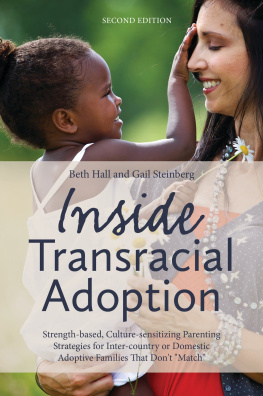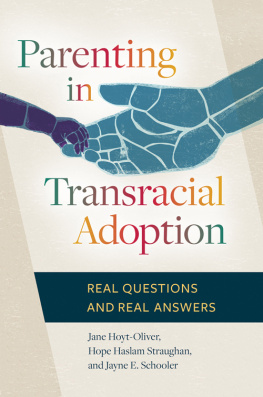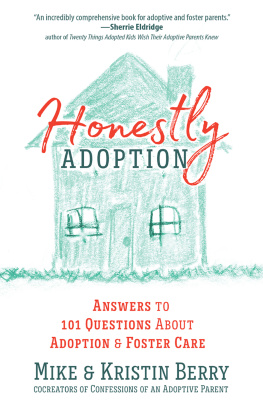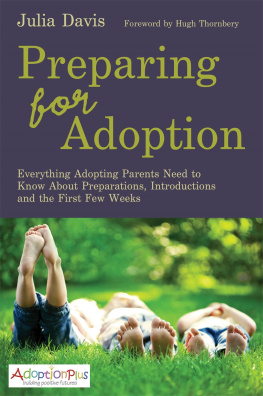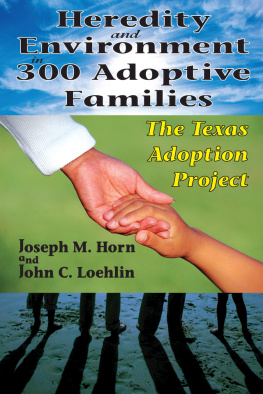Being an adoptive parent is immensely satisfying, as I know from personal experience. In addition to the other joys parents know, we who have adopted sometimes marvel at the serendipitous creation of our familyadults and children who probably would never have known each other have become a family with deep attachments to one another.
I believe our enjoyment is enhanced, though, by greater insight into our childrens thoughts, feelings, fears and experiences, as well as into our own psychological development as adoptive parents.
This book is intended as both a look at life in the adoptive family and as an ongoing source of informationa book parents will pick up again and again as their family progresses from adjustment to attachment to adolescence and to adulthood.
The need for a book like Raising Adopted Children was demonstrated more than thirty years ago by sociologist H. David Kirk. Surveying adoptive parents in the 1950s, Kirk found that some adoptive parents tried to view themselves as just parents and did not want to recognize the ways the adoptive family is different from the biologic family.
But there are differences. The primary difference is that our children have another set of parents. This is not typical in our culture, and children must struggle to understand what it means for them in their family and in society.
Just as our children grow up with the knowledge that most children live with the parents they were born to, we probably grew up thinking we would live with the children born to us. For most of usfertile as well as infertilethe role-playing and fantasizing we engaged in about parenthood did not include adoption. As a result, we are functioning in a role we did not expect to have.
Kirks research also showed that many people outside the adoptive family view adoption as a second-best way of becoming a family and even believe infertile parents are less naturally effective as parents. As false as these attitudes are, our awareness of them influences how we function as parents.
In his books Shared Fate and Adoptive Kinship, Kirk suggests it is vital for adoptive parents to acknowledge lovingly the differences between the adoptive family and the biologic familyincluding acknowledging our own pain and loss. By doing so, we can become more sesnsitive to the feelings of our children, more open to their questions, and, consequently, more able to meet their needs.
Kirk was nearly alone in the 1950s in studying adpotive familes. But in recent years, new research has given us more insight into adoptive parents and adoptees. Some of this research grew out of a genuine interest in the dynamics of the adoptive family, while other researchers, particularly those involved with heredity and environment issues, found adoptive families a convenient research sample. Whatever the motivation, we now know far more about adoptive families than we did even a few years ago.
This book provides adoptive parents with a comprehensive source of practical, reassuring advice, firmly founded on the available research as well as on the experiences of those involved with adoption.
Parents who adopt infants, older children, children of their ownrace, children of other races and ethnic backgrounds, disabled children, or children with serious behavior problems, will find the assistance they have long needed in recognizing and dealing with the special situations that arise when children are adopted.
While directed at the adoptive parent, this book is also useful for professionals such as social workers, psychologists, healthcare personnel, and teachers, who all need specific knowledge about the workings of adoptive families to serve them well. In addition, it is hoped that the adoptees who read this book will develop an understanding of the many factors influencing adoptive parents.
I have many people to thank for their contributions to this book. At the top of the list are the adoptees, adoptive parents, and birthparents who have shared their stories with me over the years, giving me a greater understanding of the universality of adoption as well as the unique experiences of individual familes. Their stories are in this book, unchanged except for minor details such as gender and age. But to protect their privacy, with few exceptions, their names have been changed.
I am also grateful to a few individuals who have repeatedly shared their remarkable knowledge of adoption with me and who have been supportive of my work: David Kirk, Ruben Pannor, and Barbara Tremitiere. David Kirks work has profoundly influenced my thinking about adoption. I have also learned to count on him for thoughtful analysis of my work, which he provided after reviewing the manuscript of this book. Reuben Pannor has shared with me his years of experience in adoption, and has given me valuable feedback both on my writing in Adopted Child newsletter and on this book. I particularly appreciate the enthusiasm he showed for this project from the beginning. Barbara Tremitiere has made herself available to me whenever I needed information about special needs adoptions. She read parts of this manuscript and offered her thoughful comments.
One cannot overstate Claudia Jewetts influence on contemporary adoption thought and practice. Her work on helping children deal with grief, helping children understand why they left one family to move to another, and her most recent ideas on how to help adolescents leave home in responsible ways are major influences on this book, and I thank her for her comments on those sections of the manuscript.
I appreciate Judith Schaffers willingness to read this book in manuscript form and offer suggestions. Individual sections were read by Josephine Anderson, Robert Bilenker, Frank Bolton, Jr., David Brodzinsky Dirck Brown, Remi J. Cadoret, Kathryn Donley William Feigelman, Jim Forderer, James Mahoney, and James McLoughlin. I appreciate the time and care they took with it.
Thanks must also go to Sue Smith and her co-workers at Adoptions in Idaho, as well as to the staff of Holt Childrens Services, who are always no more than a phone call away when I have questions, and who provided me with some of the information on children from the Philippines, Latin America, and Korea. Sue Smith has also been a helpful source of information on large adoptive families. Nancy Boucneau of International Mission of Hope detailed the experiences of children from India. Hyun Sook Han gave me a personal interview on the adjustment of Korean children. Dennis L. Murray offered helpful comments on the transmission of hepatitis B. Jim Forderer shared with me his insights into single parent adoption as well as the adoption of disabled children.
While I am grateful for all the help I received, I should make it clear that there are controversial issues in adoption as well as differing philosophies. Unless otherwise indicated, the views in this book are mine, and are not necessarily shared by all those who played a part in the books development.
In Patricia Hart I found the thorough and demanding editor I always hoped to work with someday, as well as a friend who could be called upon for help with child care and other necessary support. I would also like to thank Ivar Nelson at Solstice Press who has been a valuable sounding board for ideas since the conception of the book, and Janet Goldstein at Harper & Row who understood the need for this book.
Final thanks are saved for my husband, Carl, who showed in ways both big and small that this book is as important to him as it is to me.
Lois Ruskai Melina
January 1986
Moscow, Idaho
When I wrote the first edition of this book twelve years ago, my two children were preschoolers, just becoming aware that they had been adopted into our family As I finish this revised edition, my daughter is in her senior year of high school, becoming increasingly sure of who she is and getting ready to leave home, and my son is fourteen and in the midst of exploring his identity. When I wrote the first edition, I was looking for answers as a relatively new adoptive parent. Now I feel I can reassure new adoptive parents that the satisfaction of raising adopted children continues and the deep love we feel for our children grows. Although my journey as an adoptive parent is not over, and never will be, I believe that I am coming to a significant transition as my children approach adulthood and start to leave home. It is natural to look back at this time, and as I do I realize how much I have grown and learned as a parent, particularly as an infertile, adoptive parent. Infertility and adoption turned my world upside down, but the new perspective has been fascinating. The knowledge that our children came into our family by chance, but have become the core of our daily lives, is truly awesome and has confirmed my belief in a higher power. The process of getting to know them as they have grown and developed has been exciting and humbling. Exploring the complex dimensions of adoptive families has been stimulating, but has left me far more comfortable with unresolved paradox than I thought I could ever be. And I am sure more growth and discovery are ahead.


